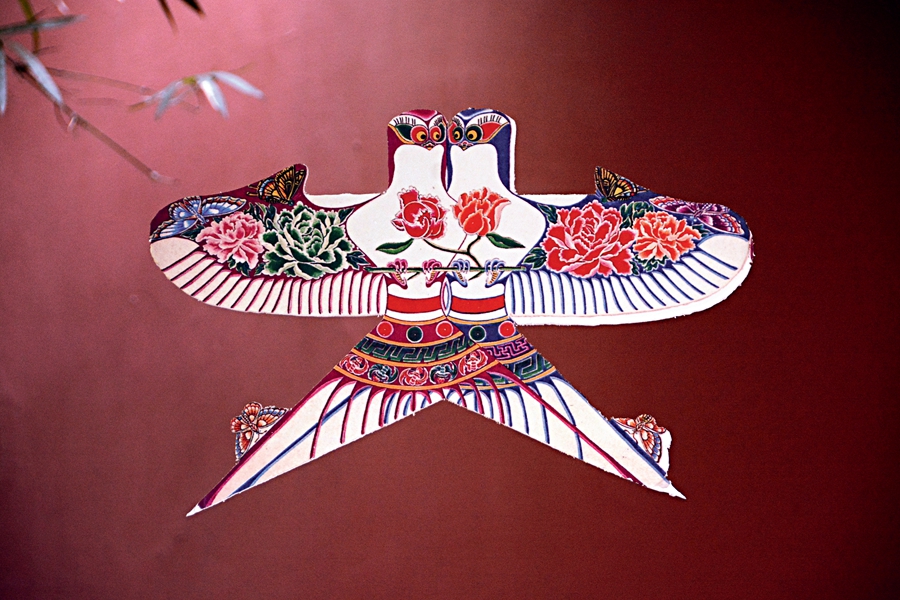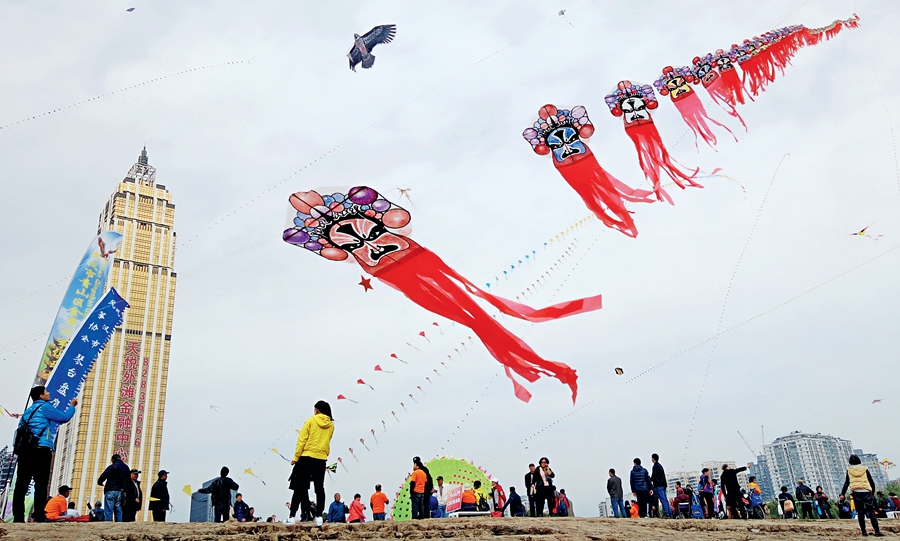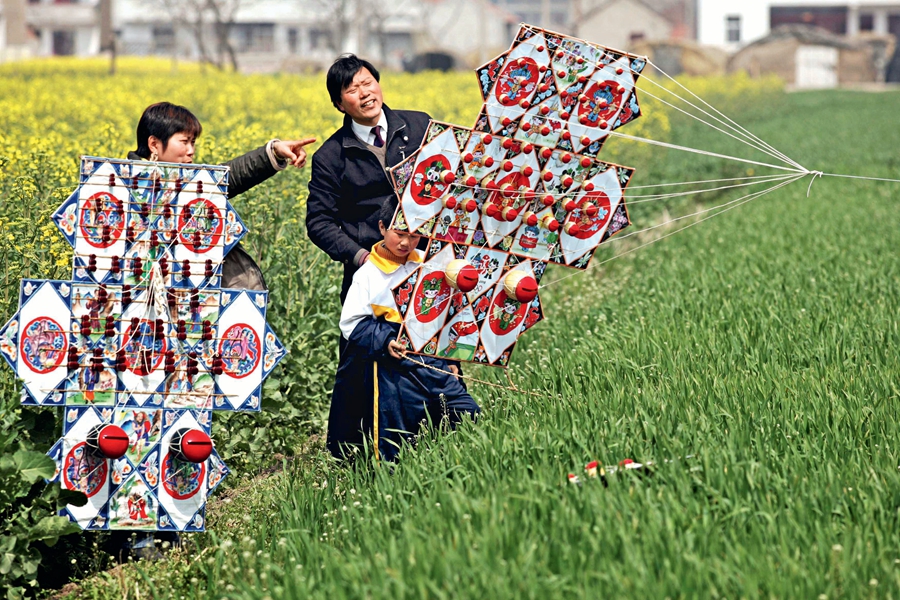KITE flying originated in China and became popular around the country. With a long history, it is reputed as the earliest aircraft. In China, the kite is known as zhiyuan (literally meaning paper eagles), as kites were normally made of paper and when they fly, they are like eagles. Kites were used for military purposes in the very beginning, such as measurement and signaling. Later kite flying gradually became a popular recreational activity. In the past, people fastened bamboo-made whistles onto a kite. While flying through the wind, it produced sound like the music produced by guzheng, a traditional Chinese musical instrument that is also known as the Chinese zither. Therefore, it has its modern name as fengzheng (feng means wind and zheng refers to guzheng). In the 7th century, kite was introduced to neighboring countries including Korea and Japan. Around the 13th century it was introduced by Marco Polo to Europe, and then it arrived in America and Australia via Europe and Arab countries.
The Traditional Chinese Philosophy Implied
A traditional Chinese kite is made of materials such as silk fabric, bamboo chips, and paper, with the help of tools including a scissor, a bottle of liquid glue, an alcohol lamp, ink brushes, and paints. The raw materials are simple, but the kite-making process is complicated. It demands high craftsmanship to make a beautiful and easy-to-fly kite.

The representative design of Beijing kites is the swallow-shaped kite.
The traditional Chinese kite also embodies harmony between human and nature, reflecting the Chinese philosophy, as well as Chinese people’s aesthetic understanding and preference.
The integration between heaven and humanity is one important traditional Chinese philosophical concept, which refers to the harmonious coexistence between humanity and nature. The spring is the season that sees growth and resurgence of all living things under warm and sunny weather. After the long cold winter, people need to go out to enjoy the balmy breeze. Then kite flying became people’s favorite activity. In summer, people rest more to avoid the scorching heat. Autumn is the season for harvest. People are busy with harvesting and enjoying mellow fruits. Winter features freezing and windy weather; therefore, it is not suitable for outdoor activities. The Chinese ancients followed the rules of nature in their daily lives.
Around the Qingming Festival (also known as Tomb-Sweeping Day), which usually falls on early April, many people fly kites in public squares, on roadsides, and along rivers. The sky is dotted with kites of different designs, such as dancing butterflies, soaring eagles, bounding dragons, and swimming fish. When people look at those kites, they feel as if they are flying away with the kites to escape the world of hustle and bustle and integrate into the nature with their body and soul.
Kite-making is a delicate craftsmanship. A traditional Chinese kite features a symmetrical structure, with the bridle fastened in the central area of the frame. The frame should be made of both hard and soft materials to help the kite keep a balance when facing the change of wind direction and power. All the characteristics of a Chinese kite correspond to the traditional Chinese philosophy implied in the Doctrine of the Mean, which emphasizes maintaining unbiased, peaceful, and balanced existence. The Doctrine of the Mean reflects the essence of Confucianism. It suggests that people should be neither tamed nor too obstinate and rebellious, but should achieve a certain balance in dealing with their lives. To live a life resembles to fly a kite. The string should be held neither too tight, or it can’t fly, nor too loose, or it will be out of control. A balance should be achieved so that the kite can fly high and stably.
Traditional designs of Chinese kites reflect Chinese people’s aesthetic preferences. The patterns often emulate both real and mythical auspicious birds and beasts, such as dragon, phoenix, butterfly, and swallow. Sometimes people write down the names of their family members on kites. When the kites fly high in the sky, they cut the string and let the kites fly away. It is said that doing so can eliminate the problems and diseases of the past winter, which will be sent away by the kites. It is a way for people to pray for blessings and good luck.
Weifang Kites
Kites first appeared in China, but they vary in different places. The representative ones are those made in Weifang City of Shandong Province, Beijing, and Nantong City of Jiangsu Province.
Weifang City, reputed as the “city of kites,” is a famous place for kite production and cultural exchange.

Flying kites in spring is a tradition in China.
Weifang kites can be traced back to the Warring States period (475-221 BC). Micius (original name Mo Di), a famous philosopher, militarist, and scientist, whose date of birth and death are unknown, spent three years to make the first eagle-shaped wooden aircraft. It also marked the origin of the kite. By the 18th century, professional kite makers emerged in Weifang. They converged along the banks of the Bailang River and the kites they made were fashionable and easy-to-fly, gaining a reputation far and wide. Whenever the market was held along the river, the kite makers saw the most thriving business. Among them there are 10 masters that were especially famous, and one of them made a kite with the design of a boy with wings of red-crowned crane as a tribute to celebrate the birthday of Emperor Qianlong (1711-1799). This design has become the representative pattern of Weifang kites till today.
The beach along the Bailang River is the best spot to fly kites. Various kite flying competitions are held there every year, making Weifang a thriving kite market, attracting kite vendors, handicraftsmen, and kite fliers from across the country. Some local famous painters have participated in kite design, making some extremely fine kites which are sold at high prices. However, people still need to make reservation in advance to buy such kites due to the high demand. The emergence of those fine kites has further promoted the development of the kite culture in Weifang.
By the turn of the Qing Dynasty (1644-1911) and the Republic of China (1912-1949), some kite makers from Weifang who used to serve the royal court lost their jobs and became folk craftsmen, which further improved the overall kite-making techniques of the place, so the Weifang kites also acquired a touch of imperial style. They look elegant and delicate, using materials such as fine silk fabric and feature realistic paintings, rendering them not only recreational, but also an art.
In 2006, Weifang kites were included into the list of the first batch of national intangible cultural heritages.
Beijing Swallow-shaped Kites
The representative design of Beijing kites is the swallow-shaped kite. Nini, one of the five Fuwa (good-luck dolls), or five official Beijing Olympic Fuwa Mascots, is created based on the Beijing swallow-shaped kites.

Nantong kites feature large and flat shapes.
Beijing abounds in swallows. Every year they return to the north as the weather becomes warmer, signifying the arrival of spring, therefore, they are considered as an auspicious bird. In the past, the kites made in Beijing featured simple patterns and were not tough enough to withstand typical Beijing strong winds. Cao Xueqin, the author of A Dream of Red Mansions, spent his later years in Beijing. He wanted to make a kite that could resist the strong wind and meanwhile show artistic beauty. He improved the traditional swallow-shaped kite by adopting the frame of a hard arm and soft wings. With the hard arm, the kite can maintain stability when flying. With soft wings, the kite looks more like a real swallow flying in the sky.
In addition, Cao used the swallows, the main figure in his kites, to personify different groups of people, for example, a fat swallow for an adult man, a slim swallow for a beautiful woman, a pair of swallows for a loving couple, a medium-sized swallow for a young boy, small swallows for children, and a baby swallow for babies.
To imitate different figures, special attention should be paid while making frames to painting patterns and images. Also the kites need to be easy-to-fly. Cao Xueqin wanted the kites to fly in a stable way in the sky, while at the same time show the corresponding dynamic state of the figures that the kites emulate. For example, a slim swallow emulates a slim woman who is a good dancer. The kite maker should make it look like a dancer in the sky when flying. Cao’s innovation of the Beijing swallow-shaped kites has significantly improved the traditional kite making craftsmanship, and has attracted many followers. Such kites have been popular in Beijing for over 200 years till today.
The kites made by Cao reflected his ideals and world views. He recorded the instructions on making kites in a book. With diagrams, Cao showed every step about how to make a kite and his understanding about the art of kites. The book is of great value in terms of history, culture, academic study, and practice.
In 2011, the traditional craftsmanship required to make swallow-shaped Beijing kites was included as a national intangible cultural heritage.
Nantong Kites
Nantong is the main production area of kites in South China. The Nantong kites feature their distinctive musical effect when flying in the sky as different whistle combinations have been fastened to the kites.
Nantong kites feature large and flat shapes, with the large ones extending as long as over three meters, and even the small ones reaching about one third of a meter. Their shapes include square, rectangle, hexagon, and octagon, with colors such as red, yellow, and black, forming a contrast with the azure sky and white clouds. The most popular are hexagon-shaped kites. Sometimes the kite maker strings several, from seven to 19 hexagon kites together. Such combination is at least one meter long, with the big one stretching four to five meters.
The defining feature of Nantong kites is about its musical sound effect. Whistles, big or small, with the number ranging from dozens to over one hundred, are fastened onto the kite. The big whistle is made of a gourd, making a sound similar to that of cello. The small whistles are made of shells of chestnut or gingko, making a high-pitched and clear sound. When the kite is flying in the air, those whistles make sounds of different tones, creating a symphony.
The process of making Nantong kites is complicated. First, choose old bamboo stem which is tough enough yet with good resilience to make the frame. Roast the bamboo chips, polish them with abrasive papers, and coat them with varnish to prevent damage by worms. It is better to make a kite on a dry and sunny day. Symmetry is vital to keep the kite balance against strong winds. After the frame is done, kite maker is going to sew the kite with silk fabric and waxed threads. The kite line should be fastened in a symmetrical way, so that it is easy to control the kites when they fly. Nantong kites usually have two tails, which are usually made of straw rope. They help the kite keep balance when flying.
The whistles on Nantong kites are usually divided into two shapes: cylindrical and globular. The cylindrical ones are made of bamboo tube or other materials, and the globular ones are made of gourds or shells of ginkgo, chestnut, or longan. As those materials are light but tough, they are suitable to be fastened onto kites and they can produce a clear and loud sound. As the mouth of each whistle and their making material varies, they produce sounds of different volumes, qualities, and tones.
As the Nantong kites are equipped with a full set of whistles, which are usually weighty, they can fly only when the wind is strong enough. The wind needs to be even stronger to fly some larger ones, which can at the same time produce a pleasant “melody.”
The traditional craftsmanship to make Nantong kites includes various techniques such as engraving, embroidering, and calligraphy writing. The process also involves sciences such as aerodynamics, acoustics, and meteorology. In 2006, Nantong kites were included into the list of the first batch of national intangible cultural heritages.
(Compiled by China Today)